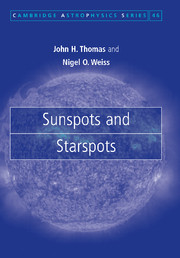Book contents
- Frontmatter
- Contents
- Preface
- 1 The Sun among the stars
- 2 Sunspots and starspots: a historical introduction
- 3 Overall structure of a sunspot
- 4 Fine structure of the umbra
- 5 Fine structure of the penumbra
- 6 Oscillations in sunspots
- 7 Sunspots and active regions
- 8 Magnetic activity in stars
- 9 Starspots
- 10 Solar and stellar activity cycles
- 11 Solar and stellar dynamos
- 12 Solar activity, space weather and climate change
- 13 The way ahead
- Appendix 1 Observing techniques for sunspots
- Appendix 2 Essentials of magnetohydrodynamic theory
- References
- Index
10 - Solar and stellar activity cycles
Published online by Cambridge University Press: 28 October 2009
- Frontmatter
- Contents
- Preface
- 1 The Sun among the stars
- 2 Sunspots and starspots: a historical introduction
- 3 Overall structure of a sunspot
- 4 Fine structure of the umbra
- 5 Fine structure of the penumbra
- 6 Oscillations in sunspots
- 7 Sunspots and active regions
- 8 Magnetic activity in stars
- 9 Starspots
- 10 Solar and stellar activity cycles
- 11 Solar and stellar dynamos
- 12 Solar activity, space weather and climate change
- 13 The way ahead
- Appendix 1 Observing techniques for sunspots
- Appendix 2 Essentials of magnetohydrodynamic theory
- References
- Index
Summary
So far, we have focused our attention mainly on the properties of individual sunspots and starspots, and their associated magnetic fields. Now we turn to systematic variations in magnetic activity and in the incidence of spots. In this chapter we shall only consider observable manifestations of activity. The magnetic fields that emerge through the surface of a star are actually generated in its interior, by dynamo processes which will be discussed in Chapter 11.
We begin by describing the well-known sunspot cycle, with an average period of about 11 years, which was first recognized by Schwabe (as explained in Section 2.2). This cycle is apparent in the record of telescopic observations, though it was interrupted during the Maunder Minimum in the seventeenth century. Fortunately, the record can be extended back through hundreds, thousands and tens of thousands of years by using measured abundances of cosmogenic isotopes as proxy data. These data confirm that similar grand minima are a regular feature of solar activity, and we can explore their statistical properties.
Next, we turn to other Sun-like stars. As expected, they can exhibit activity cycles too, although these are most apparent in middle-aged slow rotators, like the Sun itself. Younger, more rapidly rotating stars are much more active but their behaviour is erratic and less obviously periodic, as can be seen in Figure 1.7.
10.1 Cyclic activity in the Sun
Figure 2.3 shows how the area covered by sunspots has varied over the past 130 years (since the daily Greenwich photoheliographic record was initiated).
- Type
- Chapter
- Information
- Sunspots and Starspots , pp. 184 - 193Publisher: Cambridge University PressPrint publication year: 2008

